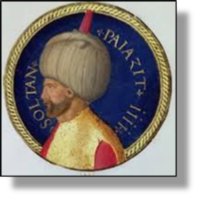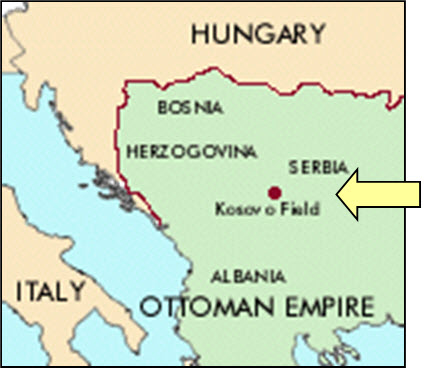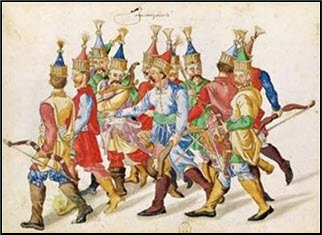


Including:
Bayezid I

THE OTTOMAN EMPIRE
THE BATTLE OF KOSOVO 1389 (R2)
xxxxxAs we have seen, in 1345 (E3) the Ottoman leader Orhan had gained a foothold on the peninsula of Gallipoli, and by 1377 his successor, Sultan Murad I, had advanced deep into the Balkans and forced the Byzantine Empire to pay tribute. He resumed his campaign three years later and, in 1389 his son, Bayezid I, completed the conquest of the Balkans by defeating the Serbs at the Battle of Kosovo. He then moved into Hungary, and at the battle of Nicopolis in 1396 defeated a force of crusaders which had been hurriedly assembled to try to stop his advance. In the meantime he laid siege to Constantinople, aiming to starve the city into submission. But the speed of Bayezid’s advance alarmed the Mongol leader Tamerlane. He abandoned further designs on India and, as we shall see, in 1402 (H4) took on the Ottoman Turks.
xxxxxAs we have seen, in 1345 (E3) the Ottoman leader
Orhan had gained a foothold on the peninsula of Gallipoli. By the
end of the reign of Edward III, his successor, Sultan Murad I, by a
series of victories -

 xxxxxIn 1380 Murad resumed his offensive. He extended
Ottoman power into eastern Anatolia, and then his son, Bayezid I (illustrated) completed the Turkish hold
on the Balkans by a decisive victory over the Serbs at the Battle of
Kosovo in 1389. At first, victory was in
the balance. A Serbian nobleman,
pretending to defect to the enemy, found his way to Murad’s tent and
killed him with a poisoned dagger. Confusion reigned for a while,
but then his son took control of the battle and, surrounding the
Serbian army, dealt it a crushing and decisive blow.
xxxxxIn 1380 Murad resumed his offensive. He extended
Ottoman power into eastern Anatolia, and then his son, Bayezid I (illustrated) completed the Turkish hold
on the Balkans by a decisive victory over the Serbs at the Battle of
Kosovo in 1389. At first, victory was in
the balance. A Serbian nobleman,
pretending to defect to the enemy, found his way to Murad’s tent and
killed him with a poisoned dagger. Confusion reigned for a while,
but then his son took control of the battle and, surrounding the
Serbian army, dealt it a crushing and decisive blow.
xxxxxBayezid, nicknamed “lightning”, continued his father’s campaign in Anatolia and in 1395 invaded Hungary. Deeply concerned at this advance into eastern Europe, an army of European crusaders was hurriedly assembled, but Bayezid met the force at Nicopolis in September 1396 and the crusade was crushed. For some ten years, too, he blockaded Constantinople, aiming to starve the city into submission. He might well have achieved this aim and completely overthrown the Byzantine Empire at this stage had it not been for the Mongol leader Tamerlane. Bayezid’s “lightning” advance, especially in Anatolia, had given the Mongol leader cause for alarm. In order to secure his western flank he abandoned further designs on India and, as we shall see, in 1402 (H4) turned his attention onto the Ottoman Turks ... and he was not a man to lose a fight.
 xxxxxIncidentally, it was Murad I
who originated the Janissary Corps,
an elite fighting force which gained a well-
xxxxxIncidentally, it was Murad I
who originated the Janissary Corps,
an elite fighting force which gained a well-
Acknowledgements
Map (Kosovo): source unknown. Bayezid I : 16th century, artist unknown – National Library of France, Paris. Janissary Corps: 1583, artist unknown – National Library of France, Paris.



R2-